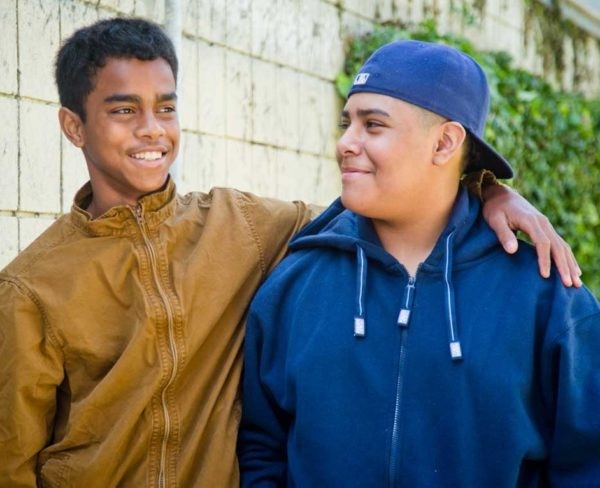Get to Know a Grantee blog – SBCS, San Diego, California
Body
South Bay Community Services was founded in 1971, located just south of San Diego, California, in Chula Vista. In 2020, South Bay Community Services changed its name to SBCS to reflect the fact that many of its programs were located countywide rather than just serving South Bay. The National Clearinghouse on Homeless Youth and Families (NCHYF) spoke with staff members from SBCS, a Family and Youth Services Bureau (FYSB), Runaway and Homeless Youth (RHY) Program grantee, to learn more about working with youth at risk of experiencing homelessness in San Diego County.
SBCS’s mission is to "transform communities to support the well-being and prosperity of San Diego children, youth, and families,” says Stacey Musso, SBCS Department Director for Behavioral Health and Wellness. Since 2007, the SBCS RHY-funded Transitional Living Program (TLP) has provided up to 18 months of transitional housing and assistance for youth ages 18 to 22. In 2022, the TLP served 18 youth (14 female and 4 male). Of these youth, roughly 78 percent were Hispanic, 11 percent were African American, 5 percent were Asian American, and 5 percent were Pacific Islander. Over 75 percent of youth served reported living with some form of disability or mental health disorder. In terms of sexual orientation, four of the youth identified as bisexual and one as questioning. Many of the youth possessed high school degrees or had a source of income.
SBCS is located approximately five miles from the U.S.-Mexico border and the area is considered a hot spot for human trafficking. The staff are trained on how to identify and respond to factors for human trafficking during the initial assessment and as youth begin to disclose more about their histories in the program. Staff are also trained to observe possible signs of human trafficking even before youth enter the program. For example, youth may disclose something about their current living situation or have multiple mobile phones, which might signal that they are in a trafficking situation.
The goal of the TLP is to help youth form and follow a plan to transition out of housing instability. Emma O'Brien, Case Manager for the TLP, explains that case managers collaborate with each youth to develop individualized goals that are then used to create a personalized service plan. Case managers review plans with TLP members at least monthly in one-on-one sessions and work with youth to update plans every three months. Although the plans vary depending on the youth's needs, many include similar goals. SBCS case mangers use multiple strategies to support youth experiencing psychological challenges such as depression or anxiety or dealing with financial or educational challenges. Among these are collaborating with local mental health services, establishing a career pathway, and helping youth increase their financial stability by building their credit and participating in the TLP financial skills training. Case managers also assist youth obtain employment and assist with pursuing educational goals, such as working toward becoming a CNA (certified nursing assistant) or earning another certification.
Alexis Johnson, Program Coordinator for Homelessness Support, explains that some youth who are making plans for life after leaving the TLP are reluctant to live with a roommate, even though this is financially preferable. TLP Case Managers continue to support these clients in obtaining stable housing by providing assistance in identifying roommates or encouraging them to rent a room instead of an apartment for longer-term stability. "Housing stability is interconnected with achieving all the other goals, too," says Xavier Martinez, Program Director for Youth in Transition.
TLP case managers work with youth to make them more comfortable with the idea of having roommates by teaching them how to be a good roommate and a good tenant. As part of this process, youth at the TLP who are assigned to live together fill out a healthy roommate agreement which helps them learn their roommates’ likes and dislikes, frequency of visitors, telephone usage, music listening volume, housekeeping habits, and more. As youth work on their future housing plans after exiting the TLP, case managers can also assist with successful pairings of youth who are seeking roommates, always with the permission of each roommate.
San Diego County has high housing costs, making it more difficult for youth who complete the TLP to find affordable places to live. That said, last year, more than three-quarters (77 percent) of youth completing the program were able to obtain stable housing, despite the rising cost of housing in San Diego. Musso says that the key to this achievement involves helping youth identify affordable, reasonable living situations, through a combination of careful budgeting and realistic expectations.
Learning financial literacy skills is key to building financial stability. An initial strategy for SBCS’s case management approach is to help youth learn how to create and maintain a budget. Over time, as youth maintain their budgets, case managers observe them taking ownership over their expenses and developing strategies for living. With the budget in place, O’Brien says, some of the questions that come up include: What are some ways I can reduce my expenses? What are some ways I can have fun but not spend as much? and What are ways that I can increase my income? O’Brien also observes that learning about budgeting helps youth think more critically about their career paths, noting that working youth often seek opportunities to increase their income by looking for a better paying job or increasing hours worked.
SBCS houses youth using a scattered-site housing model, which SBCS defines as placing youth at different locations within the community, rather than housing them at one central location. Using this model, the SBCS TLP currently houses youth in two houses and in units that are available in an apartment complex. The TLP also ensures that participants are always paired with at least one roommate. Martinez says that living within the community is a better model for the youths’ housing arrangements after completing the TLP, giving them practice, while they are still part of the TLP, with getting along with neighbors and handling everyday matters such as trash collection, parking, or transit. It also helps them to build life skills and competencies for sharing a space with roommates. The program also uses residential advisors (RAs) who supervise and do safety checks throughout the night. Using a scattered-site model can require additional efforts for a case manager to connect with youth every week. Martinez emphasizes the importance of communication among all staff members who are in regular contact with youth and providing comprehensive support to successfully manage a scattered-site model.
The TLP can make a big difference for youth experiencing homelessness at a critical time in their lives. O'Brien highlights the experience of a youth who recently completed the program after about 15 months. "A youth came in with significant mental health issues, which was a constant battle for them. Despite that, they were working full-time and going to school part-time. And throughout the program, with lessons learned from the TLP financial literacy training, they were able to save $16,000—which is incredible, to say the least.” O’Brien added that the youth was able to find secure, reliable, and stable roommates with whom they rented a nice house. While enrolled at the TLP, having day-to-day housing stability also made it possible for this youth to find a full-time, stable job that paid very well, which helped them to achieve financial stability.
After more than 50 years in business, SBCS is deeply rooted in the community, building partnerships with many organizations. These include the McKinney-Vento liaisons at local public schools, local community colleges, the Chula Vista Police Department's homeless outreach teams (HOT), and many others. SBCS operates an LGBTQIA2S+ drop-in center, called Our Safe Place, in collaboration with San Diego Youth Services, South Bay Youth Center, and the San Diego YMCA. It has partnerships with many specialized nonprofits, including the Urban Street Angels, who fight to end youth homelessness; Home Start, which addresses child abuse and parenting issues; the Urban Corps of San Diego County, which helps youth obtain their GED and find long-term employment after doing so; and Humble Design, which decorates and fills the youth’s living space with furniture and other household items.
When asked about advice they would give to other organizations with a similar mission, Department Director Musso suggests "having an individualized approach to the youth—listening and being mindful of the issues that are arising with a particular young person, and not generalizing or assuming that you know more about their experience." Johnson also notes the value of shared housing for youth (i.e., having a roommate) and encourages organizations to develop roommate-matching systems that youth can use voluntarily when they complete the program. Regardless of the local cost of housing, she says, "There is a huge benefit in shared housing. Having a roommate cuts the cost of living almost in half, allowing youth the ability to save. It offers youth the ability to build their credit, work part-time, and go back to school, which can lead to a better chance of getting higher-paying jobs." She also feels that the long-term outcome of youth participating in shared housing upon exiting the TLP can help to end generational poverty.
Website: https://sbcssandiego.org
Twitter: @SBCSSanDiego
Instagram: sbcssandiego
Facebook: https://www.facebook.com/SBCSSanDiego/

